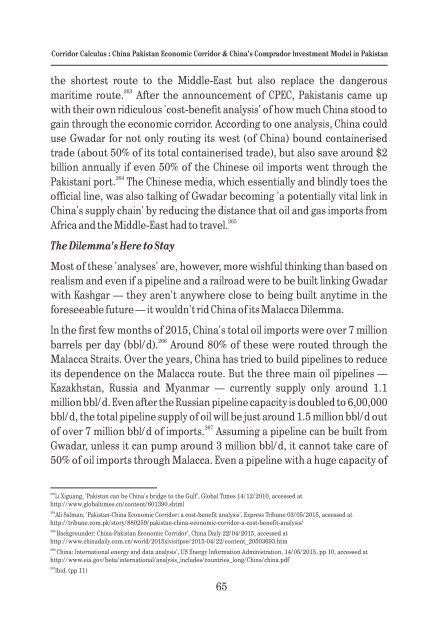Corridor Calculus
corridor-calculus-china-pakistan-economic-corridor-and-china-s-comprador-investment-model-in-pakistan
corridor-calculus-china-pakistan-economic-corridor-and-china-s-comprador-investment-model-in-pakistan
Create successful ePaper yourself
Turn your PDF publications into a flip-book with our unique Google optimized e-Paper software.
<strong>Corridor</strong> <strong>Calculus</strong> : China Pakistan Economic <strong>Corridor</strong> & China's Comprador Investment Model in Pakistan<br />
the shortest route to the Middle-East but also replace the dangerous<br />
263<br />
maritime route. After the announcement of CPEC, Pakistanis came up<br />
with their own ridiculous 'cost-benefit analysis' of how much China stood to<br />
gain through the economic corridor. According to one analysis, China could<br />
use Gwadar for not only routing its west (of China) bound containerised<br />
trade (about 50% of its total containerised trade), but also save around $2<br />
billion annually if even 50% of the Chinese oil imports went through the<br />
264<br />
Pakistani port. The Chinese media, which essentially and blindly toes the<br />
official line, was also talking of Gwadar becoming 'a potentially vital link in<br />
China's supply chain' by reducing the distance that oil and gas imports from<br />
265<br />
Africa and the Middle-East had to travel.<br />
The Dilemma's Here to Stay<br />
Most of these 'analyses' are, however, more wishful thinking than based on<br />
realism and even if a pipeline and a railroad were to be built linking Gwadar<br />
with Kashgar — they aren't anywhere close to being built anytime in the<br />
foreseeable future — it wouldn't rid China of its Malacca Dilemma.<br />
In the first few months of 2015, China's total oil imports were over 7 million<br />
266<br />
barrels per day (bbl/d). Around 80% of these were routed through the<br />
Malacca Straits. Over the years, China has tried to build pipelines to reduce<br />
its dependence on the Malacca route. But the three main oil pipelines —<br />
Kazakhstan, Russia and Myanmar — currently supply only around 1.1<br />
million bbl/d. Even after the Russian pipeline capacity is doubled to 6,00,000<br />
bbl/d, the total pipeline supply of oil will be just around 1.5 million bbl/d out<br />
267<br />
of over 7 million bbl/d of imports. Assuming a pipeline can be built from<br />
Gwadar, unless it can pump around 3 million bbl/d, it cannot take care of<br />
50% of oil imports through Malacca. Even a pipeline with a huge capacity of<br />
263<br />
Li Xiguang, 'Pakistan can be China's bridge to the Gulf', Global Times 14/12/2010, accessed at<br />
http://www.globaltimes.cn/content/601390.shtml<br />
264<br />
Ali Salman, 'Pakistan-China Economic <strong>Corridor</strong>: a cost-benefit analysis', Express Tribune 03/05/2015, accessed at<br />
http://tribune.com.pk/story/880259/pakistan-china-economic-corridor-a-cost-benefit-analysis/<br />
265<br />
'Backgrounder: China-Pakistan Economic <strong>Corridor</strong>', China Daily 22/04/2015, accessed at<br />
http://www.chinadaily.com.cn/world/2015xivisitpse/2015-04/22/content_20503693.htm<br />
266<br />
'China: International energy and data analysis', US Energy Information Administration, 14/05/2015, pp 10, accessed at<br />
http://www.eia.gov/beta/international/analysis_includes/countries_long/China/china.pdf<br />
267<br />
Ibid. (pp 11)<br />
65


